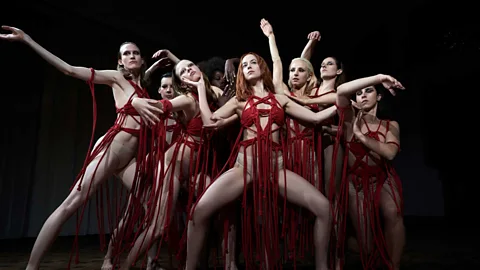Film review: Suspiria is ‘just not very scary’
 Amazon Studios
Amazon StudiosLuca Guadagnino has reinvented the 1970s horror classic into a distinctive and impressive new film. The trouble is, writes Nicholas Barber, it’s boring and fails to scare.
Dario Argento’s Suspiria is one of the most beloved horror films of all. Four decades after it was released, it is still as stomach-turningly gory as it gets. But what makes it a cult classic is its surreal fairy-tale atmosphere, its jaw-droppingly ornate, theatrical sets, and a soundtrack that is just as psychedelic and dynamic as the visuals. Imagine if Wes Anderson, David Lynch and Gaspar Noé had organised a gothic-themed party at New York’s Studio 54, and you’ll have some idea of how overwhelming it is.
On the other hand, the script is scrappy – and that’s where Luca Guadagnino comes in. The director of Call Me by Your Name and A Bigger Splash has remade Argento’s film, and he and his screenwriter, David Kajganich, have filled in the numerous holes in the original’s plot and mythology. In Argento’s Suspiria, we learn next-to-nothing about Susie (Jessica Harper), a young American who enrols in a decidedly odd dance academy. But in Guadagnino’s film we see that Susie, now played by Dakota Johnson, grew up on a farm in Amish country, and used to sneak away from home to watch avant-garde recitals performed by Madame Blanc (Tilda Swinton). When she realises her dream of studying with Blanc in , she doesn’t travel to the heightened fantasy realm conjured up by Argento, but to the Berlin of 1977 (the year the original film came out), a city of danger, guilty secrets, and a certain great big concrete wall right in front of the academy.
Whereas most horror remakes are little more than fan-pandering cash-ins – A Nightmare on Elm Street, for instance – Guadagnino and Kajganich have taken Argento’s film apart, polished every component, and then reassembled it to create their own distinctive and multi-layered supernatural drama. They have included references to the Baader-Meinhof gang and the hijacking of Lufthansa Flight 181, as well as some provocative musings on the links between magic, religion and Nazi iconography. The new Suspiria also explores the medium of dance more than the old one did, so the company’s choreography is woven into the story. It’s all deeply impressive.
It’s also, unfortunately, pretty boring. Silly, baggily structured and numbingly long, the film starts slowly, with one of Susie’s fellow students (Chloë Grace Moretz) visiting her aged Jewish-German therapist and babbling some clumsy exposition about the mysterious goings on at the school. It gets even slower after that. The screenplay establishes early on that Blanc and her colleagues are witches, so there is no mystery to speak of. And while it is quite funny to see them smoking and reading newspapers in the staffroom as they grumble about the coven’s politics (they’re probably writing application letters to Hogwarts, too), none of the witches is interesting as a person. Nope, not even the one played by Swinton. As for Susie, she doesn’t seem bothered by what’s happening – not that much is happening – so you don’t feel the tension you normally would for a protagonist who shares her lodgings with a gang of homicidal maniacs.
In fact, Susie has nothing to do in the film except go to her dance classes, and so the therapist becomes the de facto protagonist in her place. He is the one who investigates the disappearance of Moretz’s character, and he is the one with a fascinating, tragic back story. But Guadagnino has made the regrettable decision to have this old German man played by a well-known younger actor – I won’t say who – masked in prosthetic make-up. You can ire the audacious trickery, but it doesn’t serve any obvious purpose apart from distracting you from what he is saying. The same goes for the music, to an extent. Suspiria is the first film to be scored by Radiohead’s Thom Yorke, which is quite a coup, but whenever you hear him warbling, you think, “Ooh, that’s Thom Yorke!”
All of the above is a roundabout way of saying that Suspira is just not very scary. I expected to be peering at the screen between splayed fingers, but instead I was peering at my watch. One gruesome scene will be adored by fans of Cronenberg-ish bone-crunching body-horror, and there is a witches’ sabbath that is so gloriously over the top it must have had Argento chuckling. But, those scenes aside, most of the frightening parts are confined to dream sequences. They may well have been inserted to stop viewers drifting into a dream state of their own.
★★☆☆☆
If you would like to comment on this story or anything else you have seen on BBC Culture, head over to our Facebook page or message us on Twitter.
And if you liked this story, sign up for the weekly bbc.com features newsletter, called “If You Only Read 6 Things This Week”. A handpicked selection of stories from BBC Future, Earth, Culture, Capital and Travel, delivered to your inbox every Friday.
